SUMMER TIDE
Elyse Buchman snapped this peaceful scene in her hometown of Stony Brook on June 14 while having a sunset dinner with her husband at the Hercules Pavilion.
Send your photo of the week to [email protected]
SUMMER TIDE
Elyse Buchman snapped this peaceful scene in her hometown of Stony Brook on June 14 while having a sunset dinner with her husband at the Hercules Pavilion.
Send your photo of the week to [email protected]
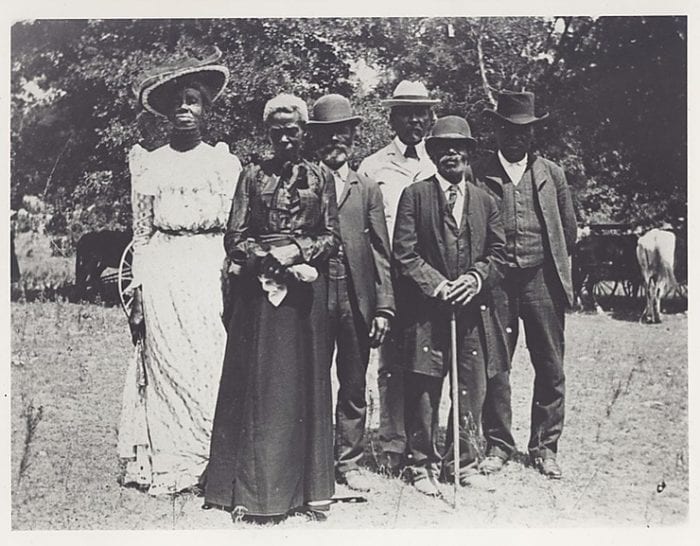
This article originally appeared on the Three Village Historical Society website and is reprinted with permission.
By Tara Ebrahimian
Juneteenth, first established by the Black community of Texas in 1866, is now getting in New York State the recognition it has long deserved. On June 17, 2020 Governor Andrew M. Cuomo announced that he would, by Executive Order, recognize Juneteenth as a state holiday, and put it before the New York legislature to make this mandate, law. Although Juneteenth began in the South, it is widely observed throughout the country. It is annually observed in New York, including on Long Island, through independent and collaborative celebrations. Juneteenth’s historic and cultural relevance impacts the entire nation and remains hugely significant for Black heritage and United States history.
It commemorates June 19, 1865, when enslaved Blacks learned that they were legally free. Union Army General Gordon Granger arrived with his troops in Galveston, Texas, and made a profound announcement: the war and slavery were over. Technically the war ended when General Robert E. Lee surrendered on April 9, 1865, and the Emancipation Proclamation, effective January 1, 1863, freed enslaved persons in Confederate states, but the news had not been shared in Texas. It was the last stronghold of slavery. Since 1862, when New Orleans was captured, slave owners from Mississippi, Louisiana, and other southern states had moved with their slaves to Texas. There were approximately 250,000 enslaved people residing in Texas when the declaration was made.
Granger’s delivery of the news did not result in an immediate end of slavery. Blacks in Galveston initially celebrated the revelation, but the mayor contradicted the law and forced them to go back to work. It was largely left to the slave owners’ discretion whether they informed individuals that they were no longer enslaved. Many did not initially share the information and instead waited for the arrival of a government agent to tell them. Blacks were frequently not informed until after the harvest. A number of newly emancipated individuals ignored the censure to stay put and left for Arkansas, Louisiana, and Oklahoma. They did so at their own risk; there were numerous reports of Blacks being lynched as they tried to leave.
In 1866 freed people in Texas, in conjunction with the Freedmen’s Bureau, organized formal celebrations for “Jubilee Day.” During the years immediately after the war, Jubilee Day was sometimes celebrated on January 1st, a reference to the enactment of the Emancipation Proclamation. It also functioned as a rally for political and social advancement; Jubilee Day frequently offered instruction for voter registration and participation. The day became a mainstream event in Black communities and featured festivities, activities, and food.
Segregation in cities prohibited Blacks from going to public parks. Church grounds were often used as sites for the events. And, freed individuals pooled money to purchase land on which to hold celebrations. For example, Black community leaders, led by Reverend Jack Yates, raised $1000 in 1872 to purchase land that is now Houston’s Emancipation Park. These annual celebrations began drawing thousands of participants throughout Texas and expanding beyond the state. By the end of the century, Jubilee Day was known primarily as Juneteenth.
During this period, many southern states enacted punitive and punishing Jim Crow legislation that undermined or undid the economic and political progress Blacks had made during and after Reconstruction. These local and state laws were designed to subjugate and stymie Black social, economic, and political development. They disenfranchised Black people through segregation and policies such as the Grandfather Clause that limited or eliminated voting rights.
Many freed people left Texas and the South in search of greater opportunities in the North. Juneteenth was a still Southern celebration and attendance outside of Texas began to wane. Younger generations, more removed from the war and seeking to distance themselves from the legacy of slavery, also started to distance themselves from participating in the unofficial holiday. As the twentieth century progressed, and people moved from agricultural to industrial employment, it was increasingly unlikely that people would be granted time off work for Juneteenth. The Great Depression, in particular, caused a migration from the country to the cities.
The Civil Rights movement caused a resurgence in awareness about Juneteenth. Black youth joined their elders in the fight for Civil Rights. There was increased interest in and engagement with history and how the past informs the present. The Poor People’s March to Washington, D.C. served as a catalyst for renewed interest in Juneteenth. Participants returned to their home states and initiated Juneteenth celebrations in locations that had never before experienced them.
In 1980, Texas was the first state to formally recognize Juneteenth; it declared the date a “holiday of significance…” At the end of the decade, California, Illinois, Wisconsin, Georgia, and Washington, D.C., were among the places that presented major events for Juneteenth. Although Congress has remembered Juneteenth in different ways over the years, it is not yet a national holiday. In New York, “Juneteenth Freedom Day” was first identified as a commemorative holiday in 2004, per a state law signed by Governor George Pataki.
Long Island hosts a growing number of events and programs dedicated to this occasion. Frequently celebrated on the third Sunday in June, modern events share certain traits with their predecessors, including picnics, cookouts, historical reenactments, street fairs, parades, etc. This year’s festivities are scaled back due to COVID-19, but certain celebrations, such as the Long Island Unity March on June 19, were still scheduled.
Author Tara Ebrahimian is the Education Coordinator at the Three Village Historical Society in Setauket — www.tvhs.org.
MEET COOKIE!
This week’s shelter pet is Cookie, an eight-year-old female Terrier mix from the Smithtown Animal Shelter who is destined to bring love and happiness to one lucky family.
With a puppy-like demeanor, a lapdog mentality and fantastic manners, Cookie is a great fit for families with kids over 12, or for the empty nester looking for the world’s best door greeter! She loves to play in the dog park and give out sloppy kisses to everyone she meets.
Cookie lived most of her life in a happy and loving home. Sadly, her former owner passed away. Her new family couldn’t provide her the safety she required and surrendered Cookie to the shelter where she now lives, waiting for that special person to come in and give her a happily ever after.
If you are interested in meeting Cookie, please fill out an adoption application online at www.townofsmithtownanimalshelter.com.
The Smithtown Animal & Adoption Shelter is located at 410 Middle Country Road, Smithtown. For more information, call 631-360-7575.
Phase 3 in Suffolk County is finally here! Effective June 24, it allows for larger gatherings of people, indoor dining at restaurants and the opening of more personal care businesses like nail salons with restrictions for safety. We sent our star reporter David Luces out on the streets of Port Jefferson last Friday to find out what the community is looking forward to the most as we move forward.
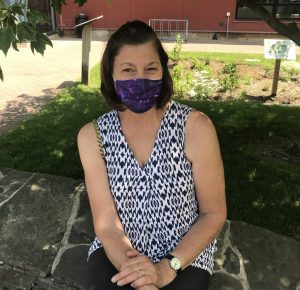
Victoria Fitzpatrick, Port Jefferson
Indoor dining is something I missed. Anything seafood or outdoors is top of the notch [for me]. If I see you’re abiding by the rules and doing what you’re supposed to be doing as a restaurant owner, then I will go in. I need to get some lobsters — there’s a place on the South Shore that I go to.
I would go back to the salon, as long as they’re doing the right thing. If they’re not doing the right thing I’m walking out. I’m a healthcare worker and I’m worried about the second wave.

Anthony Squitire, Centereach
I’ve been getting by just with takeout, but I will definitely consider going back to dine in at a restaurant once they reopen. I know museums are in Phase 4, but I would really like to go back to the Metropolitan Museum of Art in the city — it’s been like two years since I’ve been there.

Tom Adams, Shoreham
I’m looking forward to being able to go out to dinner again. I miss going to Orto in Miller Place; I like having their linguine with white clams. I also miss playing tennis and playing doubles matches. I usually play a lot with my friends in Shoreham Village. Right now, we can only play single matches only.
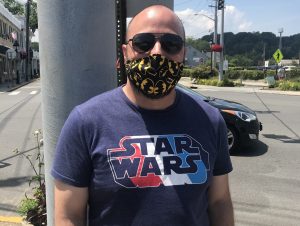
Michael Innace, Holbrook
I wouldn’t mind going back to some of the indoor dining. I see some of the places here have all the servers, workers wearing masks. I know my wife is erring on the side of caution through all of this, so she has no interest in going out to eat. So, I probably won’t be dining out just because she doesn’t really want to.
Nail salons is another thing that she is putting on hold until she feels safe to go back. I think even after Phase 4 people are still going to act cautiously. I think there are going to be residual effects.
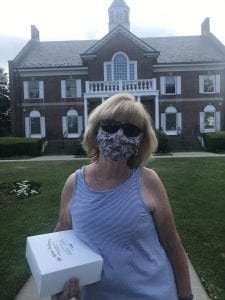
Joan Roehrig, Setauket
We did outdoor dining a few days ago, it just felt so good to be outside and sit around. I would probably want to dine in as well.
I’m not in a hurry to go back to the nail salon. I’m not sure if I’m comfortable going back right now. I’m definitely interested in getting my nails and hair done, but I’m in a wait and see mode; I’m not ready to dive in. If I saw that they were taking the proper safety precautions, I might go in.

Nora F., Port Jefferson
I’ve missed indoor dining. It’ll be a good time to go out with friends again. I’m looking forward to going back to Pasta Pasta; they just have great dishes. My daughter’s baby shower is July 12, so when I first heard that they’re opening up indoor dining, I was hopeful it will still be able to happen. Also, just being able to get my nails and hair done will be nice.
All photos by David Luces
Pierce Gardner, MD, Professor Emeritus at the Renaissance School of Medicine at Stony Brook University, is the recipient of the 2020 Dr. Charles Mérieux Award for Achievement in Vaccinology and Immunology from the National Foundation for Infectious Diseases (NFID). The award honors individuals whose outstanding lifetime contributions and achievements in the fight against vaccine-preventable diseases have led to significant improvement in public health.
Dr. Gardner’s career has centered on global health policy and training the next generation of public health providers to tackle health issues in low-resource countries. The Setauket resident has done extensive international work and has been a consultant for the World Health Organization, the Centers for Disease Control, and the Armed Forces Epidemiological Board (now the Defense Health Board). He served in many educational roles while at the Renaissance School of Medicine and remains instrumental in fostering students’ global health interests related to their career paths.
Previous recipients of this national award include luminaries in infectious diseases such as D.A. Henderson (who wiped out smallpox), Arnold Monto (a pioneer in influenza vaccine), and Kristin Nichol (a pioneer in pneumococcal vaccination).
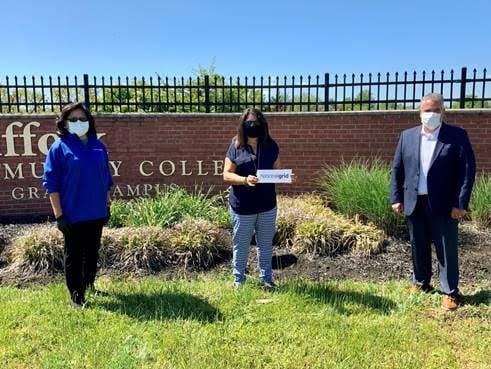
National Grid has made a generous $10,000 gift to Suffolk County Community College’s COVID-19 Emergency Fund. The fund provides critical financial assistance to students at Suffolk County Community College whose lives have been impacted by the coronavirus pandemic and has supported more than 550 students to date.
“National Grid came to the aid of our students when it was most needed” said Suffolk County Community College Interim President Louis Petrizzo. “On behalf of our students, and all of us at Suffolk, we extend our sincere and heartfelt thanks.”

Local businesses have begun to reopen and continue on their path to recovery, though it hasn’t stopped owners to continue efforts to give back to hospital workers, first responders and residents in need.

For Gary Contes, co-owner of Village Coffee Market in Stony Brook, there’s a deeper meaning to his coffee-blend-pack donations to hospital workers. He created a special blend of coffee called “Here Comes the Sun,” named after the Beatles song that is played throughout the halls when COVID-19 patients leave Stony Brook University Hospital.
“For patients, the song means a new beginning, a new day, and it’s just a sense of optimism they get,” Contes said. “So, I kind of wanted to share that same feeling with the hospital workers with this blend.”
The owner said individuals can purchase a 12-pack of the special blend for $7.50, though the catch is that they don’t get the coffee, the frontline workers do. Contes then donates the packs and makes deliveries to workers at Stony Brook Hospital and other health care facilities.
Contes said the “Here Comes the Sun” coffee is a medium roast that has a slight smoky taste to it and a “nice full body flavor.”
“I wanted to come up with a great tasting coffee which would appeal to anyone,” he added. “Everyone that buys a box, they get to write a message that will be seen by the workers who open up the box. This is our special way of saying thanks to them for all they do.”
So far Contes has donated more than 220 boxes and hopes to make it to 1,000 in the coming months.
“All our customers have been eager to participate,” he said. “It’s always very touching when we go out to deliver. Recently, we had one of the workers start to cry when she saw the boxes of coffee. My wife is a nurse, and I have other family members in the health care field, so, this means a lot to me. As a businessman who is struggling right now, if it steers people to come here and buy coffee for themselves, I would be thrilled, but if given the choice and they had to buy one item, buy a box of ‘Here Comes The Sun.’”

David Prestia, owner of Bagel Express in Setauket, has been donating meals to Mather, St. Charles and Stony Brook University hospitals for the last few months but also was suffering businesswise from the shutdown. He then came up with an idea that would get customers and the community involved.
“Our customers wanted to pitch in and help the first responders,” he said. “That’s when we came up with the sign idea.”
Prestia began selling support signs for frontline workers. The signs cost $20 with the funds going toward sending food to local hospitals and first responders. Customers are encouraged to display their signs outside their homes. He said Decal Designs Mobile only charged $5 each to have the signs made, and Michael Ardolino, founder and owner-broker of Realty Connect USA, donated funds to offset the cost.
Prestia has already sold more than 400 of the signs.
“The community got really involved and wanted to donate,” the business owner said. “It is great to spread awareness and give those workers thanks. It’s amazing how many of our signs we see in the area. It is wonderful to see. I’ve been here for 30 years and it is great to see the community coming together.”
Residents have been doing their part to help those in need during the pandemic as well.

Jake Shangold, a Ward Melville High School senior, has been raising money for Island Harvest food bank by starting a virtual food drive, www.fooddriveonline.org/islandharvest/jake.
Shangold began handing out flyers in the community and promoted the food drive on social media. He was able to raise $3,000 to help those in need of meals. With the money raised, Island Harvest will be able to provide 6,000 meals.
“I wanted to help people in need, especially with what’s going on with the pandemic,” he said. “I was very happy I was able to raise so much money, and I hope to continue doing these food drives in the future.”
Know of a Three Village business or resident doing good in the community? If so, email [email protected] to let us know.
‘Mosaics are spellbinding; they bring forth a story by constructing together a thousand little pieces, just like life is created from thousands of moments, memories, and experiences.’
– Gabriella Grama
By Irene Ruddock

Gabriella Grama is an artist who specializes in fine art mosaics and whose artistic form of expression is a fusion of modern and traditional methods. Born in Romania, she has lived in Ronkonkoma for the past 25 years where she maintains her art studio. She has exhibited in many art galleries and shows on Long Island, mainly with the Women Sharing Art group, whose most recent exhibit was at the Islip Art Museum. Gabriella also enjoys commissions where she can do a special project for someone.
How did you begin your love of art?
As a young girl, I used to visit my grandfather who was a glassmaker in Transylvania, an area well-known for skilled craftsmanship in glass, wood, and pottery. The magical experience of seeing light filtered through colored glass ignited my life-long love for glass as an art form.
When did you begin your interest in mosaics?
I was a stained glass artist for ten years before I discovered mosaics. While remodeling my kitchen, I decided to try a mosaic backsplash, and, before it was completed, I was hooked with a new passion! To improve, to learn about the different types of materials, work methods, and tools, I started to study with mosaic masters both in the United States and Italy. Each year I take workshops in Venice, Ravenna, the Chicago School of Mosaics or continue my study with mosaic masters such as Carol Shelkin, Martin Cheek, Koko Mosaico, Carole Choucair Oueijan, etc.
How would you describe the art of mosaics?
Mosaics are assemblages composed of tesserae which are small pieces of glass, stone, or other nature-based materials. These pieces are typically cut into squares or shaped using special tools. The fragments are then arranged into patterns, pictures and other decorative designs held together by an adhesive and then grouted.
What is the history of mosaics?
Mosaics have a long history. First made out of ivory, seashells, and stones, they have been around since the third millennium B.C.E. Later on, mosaics with patterns, motifs, animal and human pictures were quite widespread in Ancient Greece and Rome.
What places have you visited that have inspired you to create mosaics?
When I travel, I not only enjoy the different places, people and culture, but also seek out the mosaic treasures that inspire and educate me. Mosaic artists usually take the beaten path to Italy to visit Pompeii and Ravenna or travel to Barcelona, Spain or Istanbul, Turkey. But one could also travel to Vietnam to visit the Imperial Tombs outside of the city of Hue or visit the outstanding modern subway mosaics in Pyongyang, North Korea which I saw while on a cultural exchange.
You mentioned that you were most inspired by your visit to Pompeii. What was it about this ancient city that pulled you into this art form?
Mosaic ornamentation was widely used in the decoration of the houses in Pompeii and the workmanship was very skilled. The Pompeii mosaics are technically brilliant, showing refinement in their composition, great taste in color and superb selection of the tesserae used.
“Cave Canem,” The Battle of Alexander,” or the maritime scene of fish swimming around an octopus wrestling with a lobster are just some of the mosaics that are constantly brought forward in time, ceaselessly reproduced, and instantly recognizable.
Can you tell me about the organization Women Sharing Art and why it is so important to you?
I am thrilled to be a part of this group of Long Island women artists who work in a variety of media: photography, watercolors, ceramics, pottery, etc. Since 2008, the organization has offered grants to its members, awarded scholarships to high school artists, while providing its members with numerous opportunities to participate in Long Island art exhibits. You may view my work and the work of all of our members at womensharingart.org.
What was the theme of your most recent exhibit with the group?
In February, we participated in the “I AM at the IAM” at the Islip Museum of Art in an exhibition celebrating the 100th anniversary of the passing of the 19th amendment to the Constitution guaranteeing the right of American woman to vote. A video of the exhibition can be viewed on You Tube: “I Am at the IAM.” Another way to see it is on a film posted on the Islip Art Museum Face Book page. (www.facebook.com/IslipArtMuseum/videos)
What was your experience working with Mercy Center Ministries?
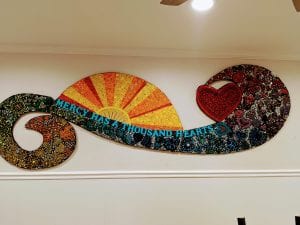
This is an independent living shelter for runaway or homeless teens. Artists from Women Sharing Art, community members, staff and residents created Mercy Has a Thousand Hearts, a unique mosaic that was installed in the Sayville Shelter. Funded by a grant received from New York State Council on the Arts and the Huntington Arts Council, the mosaic was a true work of love that gave hundreds of people the opportunity to try this form of art to express their creativity.
Is there another memorable project that has brought you fulfillment?
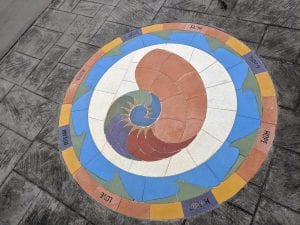
I am most proud of collaborating in 2019 with a fellow Long Island mosaic artist on the concept and design of a mosaic sidewalk medallion in Patchogue. “Nautilus Flowing” celebrates the diversity of Patchogue, its people and communities.
Tell me about your favorite piece?
One of my favorite pieces is “Effervescence”, a mosaic of a woman submerged just below the water surface. I wanted to bring to the viewer a woman experiencing a moment of solitude, serenity, and sublimity.
What are you working on now?
While I usually work on mosaic portraits (pet and human) or kitchen backsplashes, I am also experimenting with a dynamic, less traditional take on mosaics: I want to incorporate the look of weaved texture, cloth, in my mosaics. The mosaic pillows I made for a recent show inspired me to venture into a new direction. I am having a lot of fun breaking all sorts of ancient rules used in traditional mosaics!
Are you interested in teaching? How may someone get in touch with you?
Mosasics can be for everyone so all levels are invited to try it out. I currently conduct small group workshops at my studio. My contact information is [email protected], GabriellaGramaMosaics.com, womensharingart.org or Facebook: Gabriella Grama Mosaic Art.
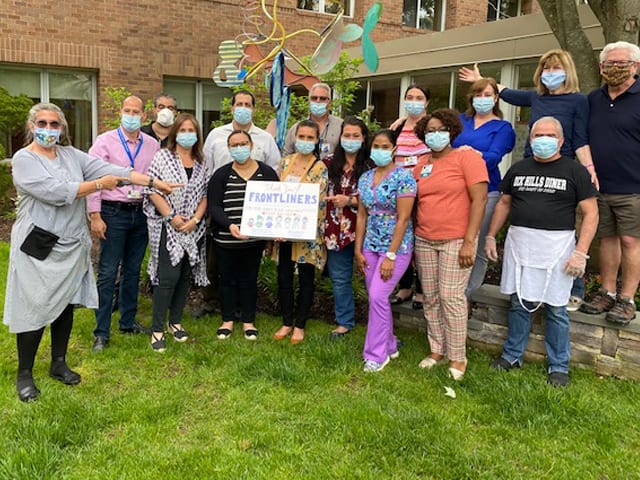
Commack: Gurwin Jewish~Fay J. Lindner Residences staff, like employees at all senior living facilities, have been on the frontline of the battle during the COVID-19 pandemic. Fortunately, a group of local community members took note and decided to treat the health care heroes at Gurwin’s assisted living facility to a pleasant and delicious surprise.
Resident family members Sue and Rob Seiler of Huntington joined with other family members to create a GoFundMe, with the goal of showing their appreciation for the dedicated Gurwin staff. After raising almost $1500, they partnered with Dix Hills Diner owners Michael Akapnitis and Peter Giannitsas to provide a delicious lunch for employees.
Seiler describes the food drop off as a win/win, showing appreciation to Gurwin staff members while giving a financial boost to the diner, also impacted by the pandemic. She says she and the others were inspired by the donations they were seeing larger healthcare facilities receive.
“This place might be smaller than some hospitals and healthcare chains, but it’s big to me,” Seiler said about Lindner Residences, a 201- apartment community where her mom has lived since 2016.
The effort provided nearly 100 meals for the staff. “Each and every one of our staff members are heroes, coming to work every day to take care of our residents despite the multitude of personal and family challenges they faced,” said Michael Letter, Administrator/COO of the Fay J. Lindner Residences. “We want to thank Sue, Rob, and the entire group for their generosity and thoughtfulness.”
Stop & Shop’s long-pending acquisition of King Kullen is no more. The announcement was made on June 10.
The two chains, along with Stop & Shop parent Ahold Delhaize USA, said they have mutually decided to terminate the deal because of “significant, unforeseen changes in the marketplace that have emerged since the agreement was signed in December 2018, largely driven by the COVID-19 pandemic.”
“Both companies have put forth an incredible amount of effort to work through unanticipated challenges that have arisen, and we regret that we’re not able to move forward,” Stop & Shop President Gordon Reid said in a statement.
“King Kullen has a strong legacy on the island, and we wish them continued success. Stop & Shop remains committed to the Long Island community, to serving our customers in the market well, and to investing in our associates and our stores in Nassau and Suffolk counties,” he said.
At the time of the acquisition deal, there were 32 King Kullen supermarkets, but three underperforming locations were closed last year including Mount Sinai on June 20 and Ronkonkoma on Aug. 22. The remaining supermarkets include St. James, Huntington, Wading River, Middle Island and Manorville. The company also has five Wild by Nature stores on Long Island including Setauket and Huntington.
“We look forward to continuing to focus on what we do best: serving our great customers across Long Island and supporting our hard-working store associates,” said Brian Cullen, co-president of King Kullen. “We are enthusiastic about the future and well-positioned to serve Nassau and Suffolk counties for many years to come. In short, we are here for the long term.”
